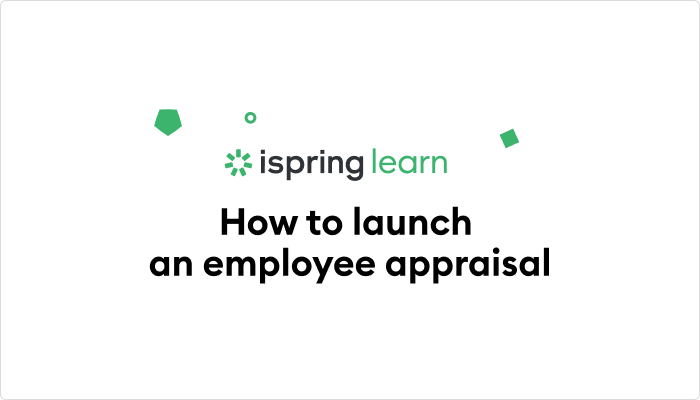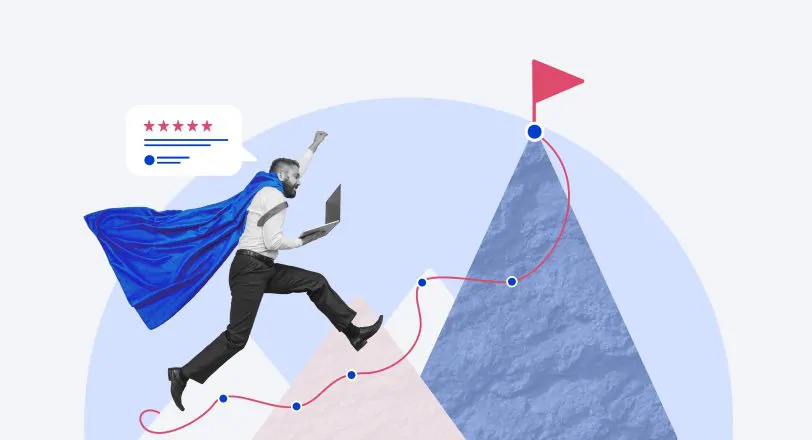Hard Skills vs. Soft Skills: Differences and Examples
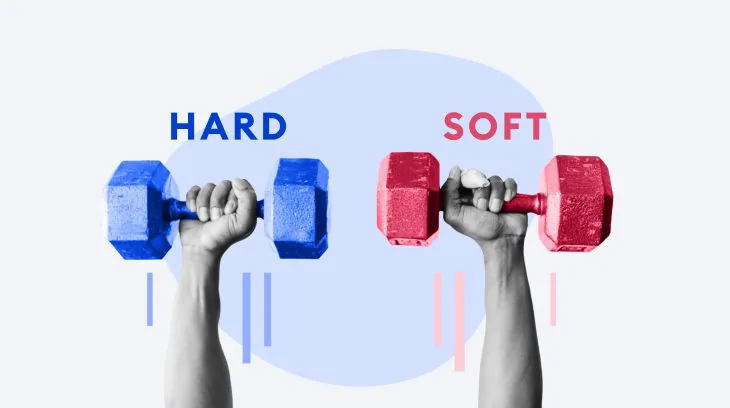
You may be surprised to know that in 2020 one of the skills that companies most wanted was emotional intelligence. Topresume’s picks for the best skills in 2021 also included emotional intelligence, along with collaboration, time management, and creativity. These might not seem like the skills that are most directly related to the profession and job duties, right?
Here are the top 10 most-wanted skills in candidates, according to the Job Outlook 2020 from the National Association of Colleges and Employers. Take a look:
| Skill | Percentage of voters |
|---|---|
| Problem-solving | 91.2% |
| Ability to work in a team | 86.3% |
| Strong work ethic | 80.4% |
| Analytical/ quantitative skills | 79.4% |
| Communication skills (written) | 77.5% |
| Leadership | 72.5% |
| Communication skills (verbal) | 69.6% |
| Initiative | 69.6% |
| Detail-oriented | 67.6% |
| Technical skills | 65.7% |
For a long time, it was the hard skills that drew the most attention and predetermined careers. But now soft skills — the ways your employees behave and communicate — are gaining increasing recognition and this matters not to recruiters only but also for L&D professionals.
In this article, we’ll bring a new, L&D perspective to soft and hard skills and show how to train your staff in them most effectively.
What Are Soft Skills?
Soft skills are the character traits, behaviors, and attitudes that affect interpersonal relationships in work and life situations. Soft skills are non-technical, so we can’t associate them with a particular sphere or industry. However, this is exactly what makes them relevant for everyone, regardless of vocational experience. That’s why soft skills are also called transferable — even if you change your career, you keep them and transfer them to your new workplace.
What Are Examples of Soft Skills?
Soft skills include the competencies that companies value in individual employees and among teams. Imagine, for example, that you see active listening as a desired soft skill in a job description. If so, then you know the company that wrote the description wants to build a cohesive team and overcome the silo mentality.
You can see these and other examples of soft skills on the illustration below:
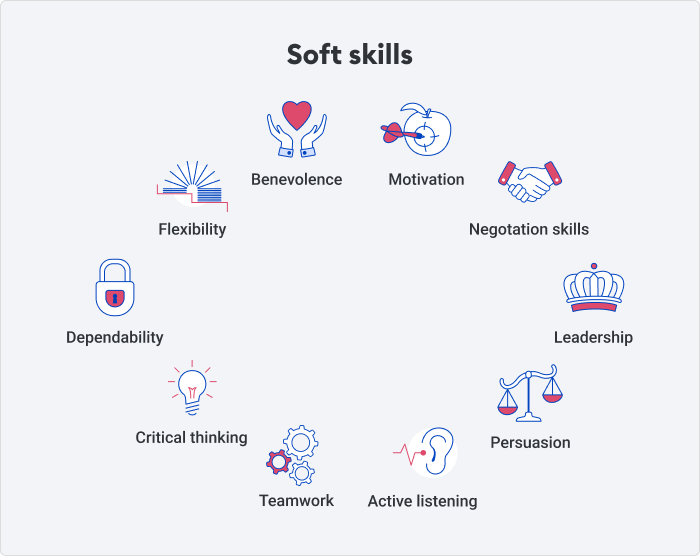
Following current global trends, the list of soft skills that employers expect from their staff members goes on and on. According to Monster’s Future of Work Global Report, the most-wanted soft skills in 2022 are:
- Teamwork/collaboration
- Communication
- Problem-solving and critical thinking
“OK, we got it: soft skills are a trending word. But isn’t it recruiters who assess them when approaching candidates?” you may ask. Soft skills are strongly associated with the hiring process, and, ironically, with resume clichés like “works well under pressure.”
But candidates who have all the needed competencies before day 1 are rare. In order to grow and retain high-performance workers, effective recruitment on its own is not enough. You also need to streamline employee development in your organization. A battle-tested way to address this challenge is training.
Why Conduct Soft Skills Training?
Here are the three major reasons why soft skills training is worth trying.
People can develop any skill
Like any other skill, soft skills can be learned. To hone them, you need training and exercise. If particular skill sets are critical for your company, corporate training will help tailor employees’ competencies to your business needs.
Robots cannot master soft skills
Soft skills training is indispensable in reskilling programs. More and more professions are automated, and artificial intelligence substitutes for people in more jobs. McKinsey & Company points out the growing need for “the social and emotional abilities machines cannot master.” Soft skills are what can address this need.
Soft skills bring tangible benefits
Soft skills training can significantly increase ROI. A study conducted in a large apparel company in Bangalore, India, showed that in-factory soft skills training returned up to 250% of the investment. How can this be?
Soft skills training affects business communication and collaboration, thereby allowing teams to work more effectively.
This is the answer.
The 3 Best Ways to Launch Soft Skills Training
Previously, when companies organized soft skills training, it would be closed-door coaching sessions on leadership for managers only. Now, as businesses recognize the importance of soft skills across the entire company, soft skill training should be accessible, flexible, and scalable.
With eLearning, you can totally achieve it. Let’s imagine you want to boost the customer interaction competencies of your sales team or customer service. You can easily improve these soft skills with the help of online training courses, dialogue simulations, and knowledge bases. Next, you’ll learn how.
Online training courses
Online courses offer a consistent sequence of slides that include modules, lessons, and assessments, united around a single topic and task. Well-arranged online courses help learners get an idea of the topic, systematize knowledge, and receive theoretical training. Use online courses to introduce learners to a particular soft skill and teach them about its importance.
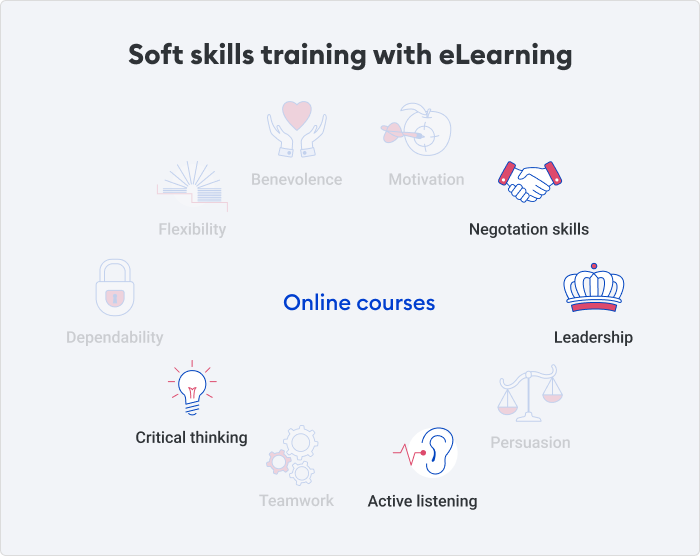
Prepare materials on objection handling, conflict mediation, negotiations, and so forth, and use authoring software to put them in appealing, slide-based courses. With iSpring Suite Max, you can build online courses like that in a snap:
You can add audio and video narrations to your course, supplement it with characters, backgrounds, and objects, and make it even more engaging with 14 types of interactive quizzes and mini games.
You can support employee self-development and encourage learners to take short courses in their spare minutes — for example, you can offer active listening exercises, small-talk techniques, or other bite-sized microlearning materials. Your learners can then study on their devices and take courses on the go, like during their coffee breaks.
Online courses can be great as a theoretical prerequisite part of offline soft skills training. But for the practical part, you can use cool eLearning interactivities, including dialogue simulations.
Dialogue simulations
Sure, offline role-playing activities in pairs still work. But they’re time-bound and tend to keep the staff from work. Instead, your employees can practice soft skills whenever and wherever it suits them, all in a simulated environment.
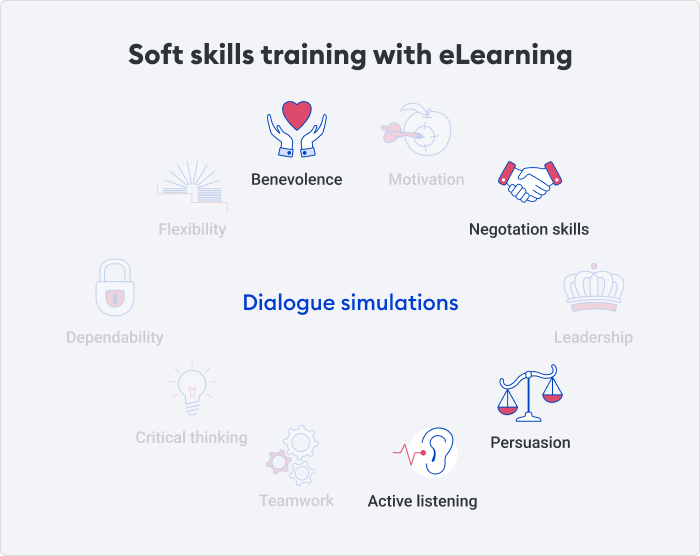
Dialogue simulation exercises imitate a real-life interaction and prompt employees to demonstrate their communication competencies. The exercises are based on branching scenarios that lead a learner to a certain outcome depending on their choices. You can play this demo and see how a branching scenario works.
These sims look good and don’t take much effort to create or revise. With iSpring Suite Max, you only need to put a script into the ready dialogue form, and then choose a character from the many options in Content Library — and that’s it. This makes dialogue simulations a cost-saving, replicable way to streamline soft skill training in your company.
Knowledge bases
Soft skills are strongly associated with personal or self-development. Simply encouraging your learners to go to the self-help bookshelf is not a working option, though. It’s much better to create a single accessible place where learners can find resources to read in their spare time. For corporate training, this place is a learning management system (LMS).
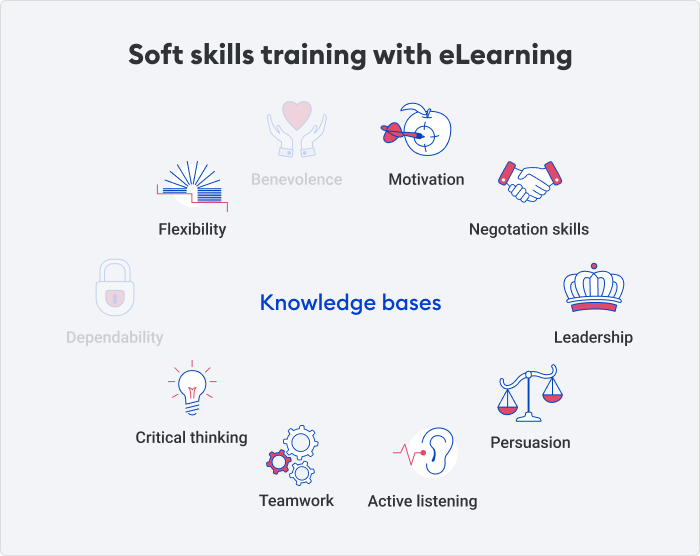
An LMS like iSpring Learn can be your online corporate university, accessible to learners anytime and from any device. Upload ebooks, videos, podcasts, and any other content about building soft skills so that employees can find something of interest and steadily improve their soft skills.
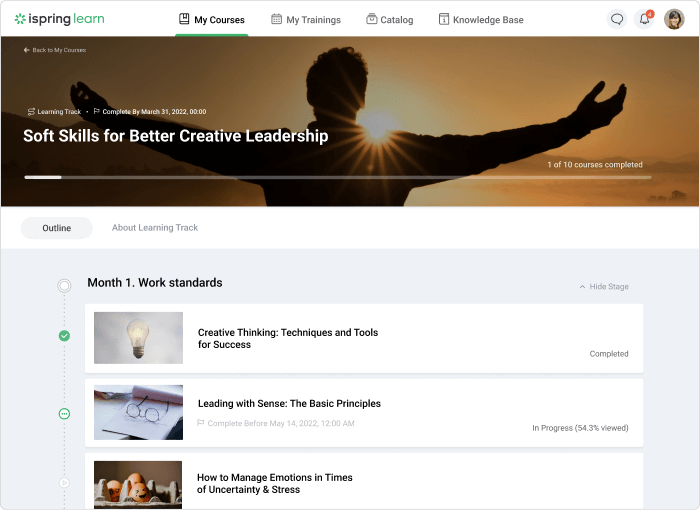
What Are Hard Skills?
Hard skills are those that refer to job duties. They are the skills people acquire through education, on-the-job practice, and work experience, and they’re usually validated by a person’s degrees, qualifications, and certificates.
What Are Examples of Hard Skills?
Hard skills encompass specific knowledge, experience, and proficiency in tools that enable an employee to perform their job responsibilities. For example, a programmer’s hard skills include CSS, JavaScript, and Python. For an interpreter, the expected hard skills are foreign languages, consecutive and simultaneous interpretation skills, and cultural competency.
The scope of hard skills is almost limitless and covers all areas of social life: economy, politics, law, culture, science and education, healthcare, military, and more. Hard skills depend on the industry, so if a person changes occupations, they’ll have to master new skills for the new job.
Also, as soon as new hard skills emerge, employees need to keep their skills up to date. And at this point, employers have to deal with massive skill gaps.
Why Conduct Hard Skills Training?
Here are the main reasons hard skills training deserves your attention.
Training will help to close skills gaps
Skills gaps can be caused by different factors, but eventually it is job-specific training that aims to close them. If you train employees in job-specific skills, then assign them refresher courses or send them to retraining programs. This way you keep them proficient on an ongoing basis and can produce better business results in the long run.
Your staff will embrace job-specific training
Employees themselves tend to acknowledge the necessity of proper hard skills training in the workplace. Just look at these groundbreaking figures from Forbes: almost half of all employees think the current training in their companies doesn’t match their actual job duties.
All of this makes hard skills training critical for future-oriented companies. But how do we organize it in an efficient, effective manner? Keep reading!
The 3 Best Ways to Train Employees in Hard Skills
Hard skills training was long associated with new hire training programs, when new hires observed the work of their experienced coworkers and learned how to perform certain tasks or work with particular software and tools. Nowadays, businesses keep training new hires in hard skills during internships.
For the rest of the workers, including those who are promoted or rotated, companies use on-the-job training, organizing mentoring sessions or collective workshops. With eLearning content, however, you can significantly improve offline training and better support your employees.
Hard skills training courses
You can make job-specific online courses that contain all the relevant knowledge for your employees to perform their daily tasks. If you have existing slides with manuals, memos, and job-related training materials, use iSpring Suite Max to convert them into online courses quickly and easily. Add pictures, videos, quizzes, and simulations to your course so your learners can retain the knowledge longer.
You can build such courses around any job-specific topic, including product knowledge, regulatory compliance, or even healthcare. Look at this beautiful course made by healthcare provider Villa St. Vincent’s with iSpring Suite Max:
Hands-on video tutorials
Another way to scale hard skill training is through videos. If you record how an instructor performs certain actions or uses software (for example, a CRM system), and put it in the relevant course, then learners will have a clear idea of what to do and how to do it correctly. With iSpring Suite Max, you can record, edit, and fine-tune training videos and screencasts without any fuss or needing extra tools.
A how-to digital job aid
Сreating an effective job aid for online access is also a good idea. A job aid can be a memo, a short video, or a quick micro-lesson that contains concentrated, task-focused information. If you prepare a number of job aids and place them in your LMS, your learners will easily find them just when they need them. Little by little, they will be constantly improving their way of work and addressing growing issues more effectively.
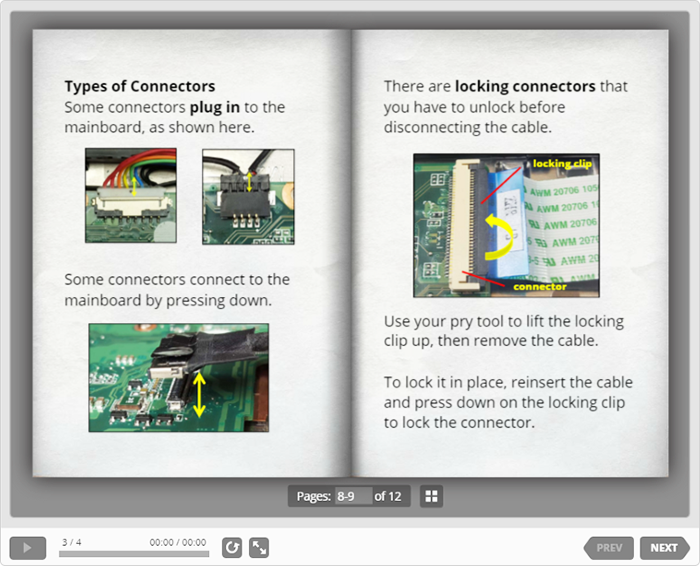
How to Evaluate Hard and Soft Skills
The skill assessment methods that companies use during the screening process include:
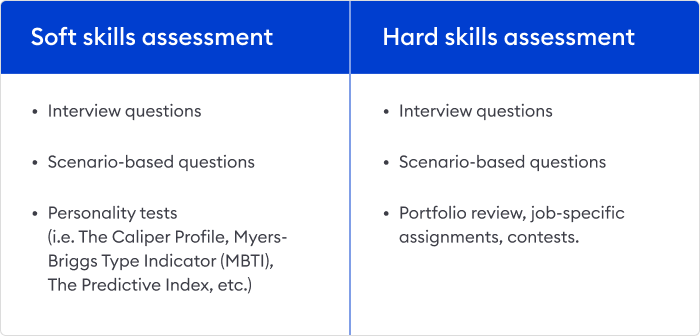
Thinking about existing employees rather than new candidates, we find many options to assess their hard skills at work. You can observe their actions, monitor performance (KPIs), and compare their achievements with others. At the whole-company level, you can conduct regular appraisals and see who needs retraining to match your standards.
With soft skills, things may seem more complicated, because people consider them to be intangible. We don’t have any kind of KPIs for soft skills. But since they are the glue of your team, you can assess team morale and identify the team members who hold it all together.
One of the tools that can help you with that is 360-Degree Feedback. Based on a rating scale, it compares anonymous feedback from an employee’s colleagues with that person’s self-evaluation. You can launch the assessment online, right in iSpring Learn: choose the preferred soft skills competencies, add relevant survey questions, and assign the survey to team members. When the survey is done, you’ll get a clear report on each employee’s soft skills, and a summary about the entire team.
As a result of the 360-Degree Assessment, you can see existing perception discrepancies in a team, as well as employees’ personal strengths and growth areas. Based on this, you can make informed decisions regarding employee soft skills training and make your team stronger.
Comparison of Soft Skills and Hard Skills
To summarize your knowledge, here is a comparative table for quick reference.
| Soft Skills | Hard Skills | |
|---|---|---|
| Driver | Personal qualities and behaviors | Qualifications, work experience |
| Examples | Communication, leadership, problem-solving, teamwork | Accounting, language proficiency, written skills, corporate law, big data |
| Scope of application | Human interaction. Customer service, sales, management; these skills are transferable | Agriculture, industry, science, medicine, art, tech, media |
| Training activities | Coaching, online courses, dialogue simulations, self-development | Mentoring, workshops, internships, on-the-job training, job aids, instructional videos, online courses |
| Evaluation methods | 360-Degree Feedback, the Caliper Profile, MBTI, the Predictive Index | Job screening, appraisals, quizzes, portfolio review, certification |
FAQs
Below are a couple popular questions about hard and soft skills:
- What are the top 5 hard skills?
Among the top five in-demand skills in 2022 are blockchain development, cloud computing, big data, web development, and content marketing.
- What are the 7 essential soft skills?
The seven most commonly mentioned skills are communication, flexibility, problem-solving, teamwork, leadership, creativity, and time management.
Conclusion
As two sides of the same coin, soft and hard skills are both important for employees’ productivity. The good news is that both of them can be trained. Employee training in soft skills and hard skills will help you attract and retain top performers, as well as enable your teams to communicate and collaborate better.
Do you conduct soft skills training in your organization? How do you bridge employee skill gaps with eLearning? Please share your thoughts in the comment section below.




